Episode #412: Going Narrow in Math Improvement: A Practical Playbook from One District
LISTEN NOW HERE…
WATCH NOW…
Math improvement plans don’t gain traction just by naming priorities—they gain traction when districts commit to going narrow. For one small district, that meant resisting the urge to spread resources across every grade and instead doubling down on a focused goal: supporting grades 3–5 teachers with the consistent use of problem strings to strengthen student fluency.
In this episode, we explore the critical leadership decisions that fueled momentum: choosing more and better over new, positioning principals as partners, and building long-term sustainability so the work doesn’t disappear if a coach or coordinator leaves.
Listeners will:
- See how a single math priority becomes the filter for PD, PLCs, and walkthroughs.
- Learn the more → better → new sequence to build momentum without piling on.
- Hear how measured success came from cultivating “bright spots”—teacher leaders modeling and sharing success with peers.
- Discover how sustainable supports were layered in by embedding problem strings into PLCs, coaching cycles, and administrator walkthroughs with a co-constructed look-for rubric.
Listen now to see exactly how going narrow creates a math flywheel—so your PD shows up in classrooms and your results compound across the year.
Attention District Math Leaders:
Not sure what matters most when designing math improvement plans? Take this assessment and get a free customized report: https://makemathmoments.com/grow/
Ready to design your math improvement plan with guidance, support and using structure? Learn how to follow our 4 stage process. https://growyourmathprogram.com
Looking to supplement your curriculum with problem based lessons and units? Make Math Moments Problem Based Lessons & Units
Be Our Next Podcast Guest!
Join as an Interview Guest or on a Mentoring Moment Call
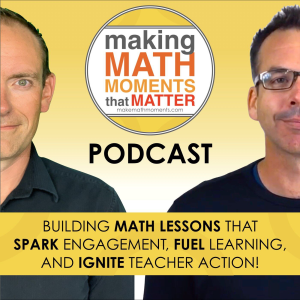
Apply to be a Featured Interview Guest
Book a Mentoring Moment Coaching Call
Are You an Official Math Moment Maker?
FULL TRANSCRIPT
Jon Orr: We’re gonna talk about what going narrow with our math improvement plan that our school levels, our district levels look like in practice. In our previous episode, so if you’re listening to this on the Thursday, it releases. In our previous episode, we talked about how, why sometimes we resist going narrow with focus and why we sometimes focus on too many things actually that kind of limits our success, limits our attraction. We talked about some theory.
in that episode and address some common pebbles that we are up against when we’re trying to change and make math improvement at our school or school district. Today what we’re going to be doing is we’re gonna unpack that same idea. Going narrow can actually strengthen your progress and strengthen your system even though that feels counterintuitive. We’re gonna talk about an example.
a district that we’ve partnered with for a number of years and have supported. We’re gonna unpack their story. We’re also gonna unpack what they’ve been focusing on and how they have gone narrow to create some traction in their math improvement planning. All right, Yvette, let’s get into it.
Yvette Lehman: excited to share the success story. I love when we are working with the district, of course, this is when we say what our impact is, or I think you actually asked me recently, what does success mean for us? It’s like when the flywheel is turning, where we see a district where they’re seeing measurable growth and the momentum is building and they have a really clear.
plan for how they’re going to continue to support this really specific but really impactful change. And so I’ll paint a little bit of a picture here. This is a smaller district. They essentially, their central team is a two-person team. They have a director and then they have a coach. So in the director, director of curriculum and then a coach who’s responsible for supporting implementation of, right, of math professional development across the system.
Jon Orr: Like, yeah, director of curriculum. Yeah. Typical structure.
Yvette Lehman: And so this district has been working with Pam Harris’s team. They have access to the problem strings, materials, access to the digital platform. But when we met with them about a year ago, they were like, the books are still sitting on the shelf. Like they know, you know, from their own experience and from the research that they’ve done that supporting the implementation of a high impact strategy like the implementation of
problem strings, so whether that’s mini lessons or Pam Harris’s work, is gonna yield the results they’re hoping for. They’re hoping to see a shift in student fluency. And so they’re like, we know this is the right path, but they recognize we just haven’t put the right supports in place.
Jon Orr: Right. And to be honest, like they also had done work on like, what is my vision here at our district? And they did some great work on collecting voices to create their vision. They also did some narrowing early on in their journey to take all the things, you know, all the things we’re floating around and try to narrow to three focus zones, which we helped them call or we just called objectives.
So they were looking at, say, supporting three objectives over the course of a number of years, and they tried to go narrow there. And I think what we did in the last year or two is to help them even go more narrow. So talk to me about what some of that looked like,
Yvette Lehman: Yeah, so last year when we were faced with this pebble, which was, know, we know that this is a great resource. It’s a high quality instructional material. We’ve done the training. know, teachers have received hours of training, but we’re just not seeing consistent implementation of this resource in all classrooms. And so the first move that they made that I thought, you know, really helped them start the flywheel is they decided on who their target was. They recognize that they have a single math coach.
one math coach supporting multiple school sites. And so they said, you know, let’s get real. It’s not realistic for the coach to support the implementation of this resource or in this instructional practice, K8. It’s not realistic.
Jon Orr: Right, it’s like, right, because we talked about, know, and sometimes we have, this is what we talked about on the previous episode, it’s like we have the ideas, like that’s what we’re gonna do, we’re gonna focus on K-date, we’re gonna make change, but then what happens, especially when you only have one coach, is you spread that coach too thin, is you, all of a sudden it’s like, well we’re gonna have cycles, and we’re gonna get a coach to go to this classroom, and then they won’t see, like then they’ll go to a different classroom, and the next day, and they’ll go to a different building, and all of a sudden it’s like three weeks or.
gone by and maybe they get back to that first classroom and maybe they don’t. when you structure it that way, again, that’s not narrow, you’re not using the structure in a narrow way, even though you may have focused your attention and the support you’re giving in a narrow way, but now you’re still too broad structurally to actually create any impact. it’s about how do I create more time with teachers so that they get the follow-up support, they get the…
I can do this, I can see it in action because teachers do need that and it’s part of that adoption model so that they can continually build upon those successes. So we’d rather see more touch points with a certain class, which means you’re targeting less classrooms. And I think that they did that here.
Yvette Lehman: Yeah, they had, so they focused on grades three to five and there was a lot of, they could justify why. You know, their K2s last year and this year are doing a really heavy lift in literacy with the implementation of UFLY. The teacher, remember, teachers can only handle a small number of shifts at a time on top of their workload of being in the classroom all day long supporting student needs. So because they’re
K2s were already doing that heavy lift. They thought that’s not the right place right now for this to support implementation. And they also knew that if students left grades three and five with greater fluency, if they were more fluent by the time they left fifth grade, they’d be better positioned to access the curriculum in sixth through ninth. So it’s like, this is why they chose to target this group. They could justify it.
So they started in the spring of last year, guess winter of last year with this really specific focus on grades three to five with a lot of coaching support. And the way that they were going to measure success was that they would measure success if they could develop enough bright spots in their system that they had teacher leaders who were positioned to lead professional development around problem strings for their peers this summer.
So that was their key result. They were like, by the end of these coaching cycles, when we get to May, we want to have identified teacher leaders at every grade level, grade three, four and five, that will be positioned as bright spots to kind of build capacity of their peers through our summer professional development opportunities.
Jon Orr: Right. And did they pick like a certain number of bright spots? How do they know like, like they were like we talked about in the in previous episode about like reverse engineering, like how do I ensure that I’m my gap between expectation and reality is as small as possible, even though we know we’re never going to be perfect, but we can also try to design the support to get as close to our goals as possible. Cause most times we just make inappropriate goals because we just aren’t clear about what
And that gap between expectation and reality is just too big right now. It’s like, well, what does it take to actually create impact? thinking about if I wanted to create bright spots, what was some of the reverse engineering they were doing?
Yvette Lehman: So the goal was one per grade level because thinking about the professional development for the summer, it’s like they wanted at least one per grade level who would be, so again, it’s not always teachers hearing from somebody from district office. Now they’re hearing from somebody who actually implemented this resource and this instructional practice in their classroom and had success. And now they’re saying to their colleagues, this is worth doing. And these are the changes that I saw.
And I can’t, you I wish I could recall how many they ended up identifying, but the goal was one per grade level so that they could kind of build momentum and build buy-in across the district. Now, here is where the real success happens. Because what do you think the gut reaction was going into planning for this year?
Jon Orr: After successive last year. Well, we need more. Right. Or we need to do go deeper or we need to add on grade levels or we need to be more precise in our goals.
But you know what, I’m gonna cut you off there, because I think more is better than new. Right, so it’s like we always say, the more, better, new. That’s the order you wanna do things in, and we usually do it in reverse. So we always cut off our more because we’re like, well, we tried that, and then we didn’t see the success we wanted because our gap between expectation and reality was too big. We picked the wrong goals, so we start anew. But actually, you should do it in the more, better, new order. Like how can we, if.
If we’re narrow, how can we do more of that and build upon success to compound our success and then can we ask ourselves if we can’t do more, can we do it better? And if we can’t do it any more better, that’s when we start to think about new.
Yvette Lehman: And I will say that they were not thinking new. It was still within, you know, I would say for sure, still specific to the supporting, you know, implementation of explicitly teaching fluency strategies and models through problem strings that, you know, create scaffolded opportunities for students to internalize these strategies and own them and use them. So I don’t think they were thinking new, but it was almost like,
And maybe it was more of a more, but I guess my question was like, you’ve started to build momentum. You now have these three bright spots, but like, what about everybody else? You know, can we create more bright spots? Like, how are we gonna leverage the bright spots that we did identify this past spring and ensure deeper internalization across all teachers at these grade levels?
may be bringing in sixth grade and that’s an opportunity that they’re exploring for this year as well is like which who are the sixth grade teachers that could be potential teacher leaders across that grade band that we want to bring into the conversation this fall but I think what the the success is they chose not to deviate from their structure or their plan they knew they just needed more and but they added some other layers to it that I think are going to strengthen it so a couple things
So they aren’t deviating. They’re gonna continue to prioritize the implementation of problem strings. But they are looking at strengthening professional learning communities as another subsystem to engage in this work. So last year it was reliant on coaching and Polo PD.
Jon Orr: Okay, I was wondering what, tell me, I wanted to make sure that everybody heard what some of the structures were utilized here to accomplish the goal.
Yvette Lehman: Right, right. So last year there was Polo PD and there was coaching. So this year they’re looking at how do they coordinate professional learning communities so that teachers are coming together, they’re seeing a problem string being facilitated, they’re participating as the student, which is really critical. It’s like in order to support the implementation of this type of resource or instructional approach, teachers need to be the student, they need to do the math as if they were the student participating in the problem string.
That’s the goal. So the goal for the PLCs this year is that they’re going to participate as students in problem strings. They’re going to leverage the professional development platform so they can watch that problem string being facilitated and they can notice and name, you know, the strategy, the model and the teacher moves so that they are better positioned to go back and implement in their classroom. And then the coach will still be there alongside them. Like that part’s not being removed.
Jon Orr: Right, right, so that was where I wanted to make sure that we weren’t stretching ourselves too thin again, is to say, who’s facilitating the PLC?
Yvette Lehman: love that you asked that. Okay, so that’s a great question, John. Who’s facilitating the PLC? So part of their plan is that initially the coach is going to be there to launch and to establish the routine. But the one thing on her radar is who is she identifying as the teacher leader who’s going to be the next facilitator so that when the coach walks away, this doesn’t fall apart.
And so those bright spots that were starting to be developed last year are going to be potentially or maybe others. Like, and that was something that has to be, and we talked about this in the coaches aware, like this is not their work. This is work that has to exist with or without. If the funding leaves next year for that role, will the PLCs continue to be leveraged in this way to support the implementation of this resource? And so that is part of the work is to identify.
And so then we talked about could the coaching time for that person actually be about facilitating PLCs? So if they’re getting coverage for an hour, could it be around instructional leadership?
Jon Orr: Totally. I love this. I love the focus on we’ve talked about this, like our flywheel, our four stage flywheel that we support our teams with, you know, the fourth component is about addressing sustainability, long-term traction. And oftentimes we hold, especially coordinators at the central level. If we have math coaches at the central level, the math plan is you and it rests on your shoulders. And when you move on, it usually goes away with you and someone else comes in and develops a new plan. And
We always, you know, are huge proponents of like, how are you building the next round of leaders and how are you bringing them into the flywheel process? Like how are you, like you could be focusing on bright spots like they were focusing on, but the fact that now they’re taking one extra deeper dive, not changing things, but one deeper dive to bring people into the leadership process so that the flywheel effect.
can keep happening because now the process is transferred. The work of trying to get narrow, the work of trying to do this work is the impactful work and communicating the leadership moves of that work is gonna ensure that it continues whether that coach or the coordinator or the curriculum coordinator step away or retire or take that next step. So they’re doing some great work here to like talk about the process. and which is about sustainability. All right. Yeah, I love it.
Yvette Lehman: There’s another piece to this plan. So we mentioned there’s two people in the central office role, right? We have our coach and then the curriculum coordinator or the director of curriculum. And so, you know, that person doesn’t necessarily have the capacity to be in schools with teachers and in PLCs, right? They cover multiple different curriculum areas, not just math. So what’s their commitment and their, you know, their work look like? And so what we’ve identified and what they identified is that
That person’s gonna work with principals this year to help principals understand the why behind this lift in implementation of problem strings and the use of the Math is Figureoutable platform as a professional development platform for teachers to build in time for them to interact with the platform and why that’s important. So one of the things that that director’s committed to now is engaging in walkthroughs with principals with a…
co-constructed look for rubric of what does implementation of an effective problem string look like, sound like, feel like, because they are also embedding problem strings into their formal teacher observation and evaluation process this year. So if a teacher is being evaluated in grades three through five this year, an expectation that it’s during math and that they are using a problem string during that time.
Jon Orr: So like a successful blend of existing processes, existing work, and in pairing it with the work that administrators already have to do and making sure that we’re educating and clarifying math improvement goals along with administration is essential and I love that they’re kind blending these two things together.
So, well yeah, here’s what I wanna ask you, is that if you, cause I know that this was a journey with this team, like they’re not in your, you this is not the first year that they started down this road with us. It’s been a few years. So when you think back, like the narrowing, because we want this episode to really be about the going, I’m gonna narrow, like we have to get more now and this team definitely did that over the course of year, but they weren’t narrow at the beginning.
Like I did say they picked some zones to work on at the beginning, which they did. But what do you think was the trigger point or the tipping point for this team to be like, I actually have to get this level of nerve.
Yvette Lehman: think that the reason maybe they weren’t narrow to begin with is because they are consumers of information and research and good practice. And so sometimes when you are somebody who is eating up, know, who listens to podcasts, attends professional development, like you hear all of these great ideas and you just want them all. maybe the reason this person wasn’t super narrow to start is just because they’re consumers of good information. You know, they’re hungry and they listen to podcasts and they read professional books and they attend conferences and they’re so passionate about this work that they want all the good things happening and they want them all happening now because they think kids deserve that. So I think that was the reason that the narrowing was difficult for this leader.
I think the turning point was the partnership between this central office coordinator and the coach. Because I think that there was a lot of trust in this partnership and they were able to get real. There were these authentic conversations about impact and reality and what is actually realistic. And you say this all the time, I quote it all the time, getting real about what you can.
realistically accomplish in a year and I think what they didn’t want was to get to the end of the year once again and not be able to articulate the change that they had to feel like they were working really really hard without a lot of impact.
Jon Orr: Yeah, no, that’s an important epiphany I think we have to make. And I think, we’ve talked about this too, is that the team, like doing this in isolation, because I think that was part of that early first year, was that there was, it was one person. And how can I do this with a team? How can I tap people on the shoulder to help me do the thinking required, the sounding board? How do I have that thought partner to keep?
us focus because I think part of that, having the accountability that we have to communicate to each other how to get this done. So even having the epiphany of like, I don’t want to get to another year, but also translating to another individual what you’ve been trying to do and realizing that that actually is feeling very spaghetti-ish. And it’s like, if I have to take all what’s in my head and tell someone else what we want to do, it almost forces us to get narrow. It forces us to get clear on what we were trying.
trying to accomplish. And then that can actually, just having the sounding board, the thought partner can actually be a clarifying, narrowing process to go through as well. So we always encourage folks to choose team members to do this work with us. So this was an example. I think this was a huge win for this team after starting down a journey that they knew they were systematizing math improvement.
across multiple school sites and how did they got narrow and how they got focused and how those epiphanies came about to be and what that actually looked like and we’re hoping to kind of give you that glimpse that this is possible to get narrow without say having that fear that traction isn’t going to happen because you didn’t cover everybody, you didn’t provide everything to everyone. This is an example of a team that got narrow and is making traction in the right ways. So we encourage you, what are the ways that you could get narrow this year?
and focus some attention to and how you’re gonna know that they had success because the last thing you want is get to the end of this year and go, what were the things we did this year and how do I know that those things had impact on our math improvement goals? And you have goals, right? Like you’ve clearly defined those goals. So let’s make sure that we have the evidence that supports the goals and the changes we’re looking to make. If you need guidance, if you need help, we’re here. This is what we do. We spend all of our days.
talking with our team partners on how to structure their goals but also structure the support around those and what that looks like from start to end. Reach out to us, makemathmoments.com forward slash district and we’ll talk about your program.
Thanks For Listening
- Book a Math Mentoring Moment
- Apply to be a Featured Interview Guest
- Leave a note in the comment section below.
- Share this show on Twitter, or Facebook.
To help out the show:
- Leave an honest review on iTunes. Your ratings and reviews really help and we read each one.
- Subscribe on iTunes, Google Play, and Spotify.
DOWNLOAD THE 3 ACT MATH TASK TIP SHEET SO THEY RUN WITHOUT A HITCH!
Download the 2-page printable 3 Act Math Tip Sheet to ensure that you have the best start to your journey using 3 Act math Tasks to spark curiosity and fuel sense making in your math classroom!
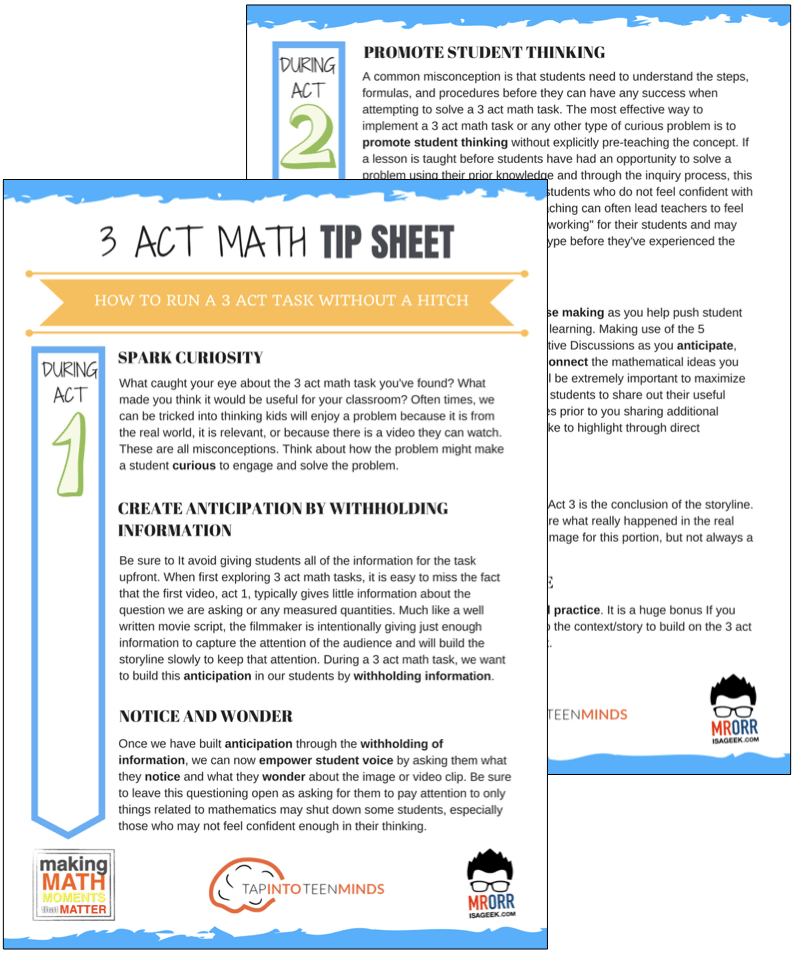
LESSONS TO MAKE MATH MOMENTS
Each lesson consists of:
Each Make Math Moments Problem Based Lesson consists of a Teacher Guide to lead you step-by-step through the planning process to ensure your lesson runs without a hitch!
Each Teacher Guide consists of:
- Intentionality of the lesson;
- A step-by-step walk through of each phase of the lesson;
- Visuals, animations, and videos unpacking big ideas, strategies, and models we intend to emerge during the lesson;
- Sample student approaches to assist in anticipating what your students might do;
- Resources and downloads including Keynote, Powerpoint, Media Files, and Teacher Guide printable PDF; and,
- Much more!
Each Make Math Moments Problem Based Lesson begins with a story, visual, video, or other method to Spark Curiosity through context.
Students will often Notice and Wonder before making an estimate to draw them in and invest in the problem.
After student voice has been heard and acknowledged, we will set students off on a Productive Struggle via a prompt related to the Spark context.
These prompts are given each lesson with the following conditions:
- No calculators are to be used; and,
- Students are to focus on how they can convince their math community that their solution is valid.
Students are left to engage in a productive struggle as the facilitator circulates to observe and engage in conversation as a means of assessing formatively.
The facilitator is instructed through the Teacher Guide on what specific strategies and models could be used to make connections and consolidate the learning from the lesson.
Often times, animations and walk through videos are provided in the Teacher Guide to assist with planning and delivering the consolidation.
A review image, video, or animation is provided as a conclusion to the task from the lesson.
While this might feel like a natural ending to the context students have been exploring, it is just the beginning as we look to leverage this context via extensions and additional lessons to dig deeper.
At the end of each lesson, consolidation prompts and/or extensions are crafted for students to purposefully practice and demonstrate their current understanding.
Facilitators are encouraged to collect these consolidation prompts as a means to engage in the assessment process and inform next moves for instruction.
In multi-day units of study, Math Talks are crafted to help build on the thinking from the previous day and build towards the next step in the developmental progression of the concept(s) we are exploring.
Each Math Talk is constructed as a string of related problems that build with intentionality to emerge specific big ideas, strategies, and mathematical models.
Make Math Moments Problem Based Lessons and Day 1 Teacher Guides are openly available for you to leverage and use with your students without becoming a Make Math Moments Academy Member.
Use our OPEN ACCESS multi-day problem based units!
Make Math Moments Problem Based Lessons and Day 1 Teacher Guides are openly available for you to leverage and use with your students without becoming a Make Math Moments Academy Member.
Partitive Division Resulting in a Fraction
Equivalence and Algebraic Substitution
Represent Categorical Data & Explore Mean
Downloadable resources including blackline masters, handouts, printable Tips Sheets, slide shows, and media files do require a Make Math Moments Academy Membership.
ONLINE WORKSHOP REGISTRATION
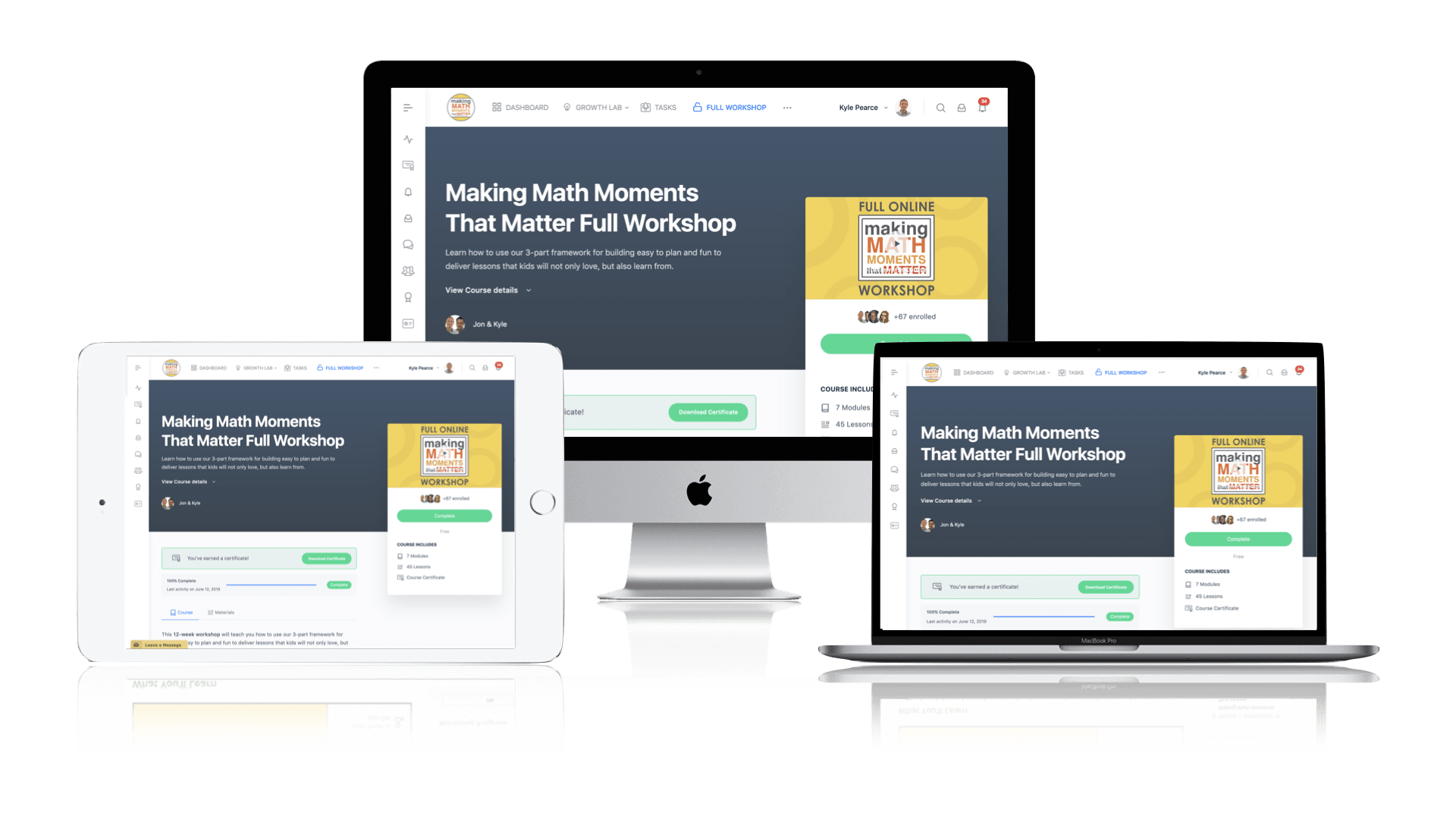
Pedagogically aligned for teachers of K through Grade 12 with content specific examples from Grades 3 through Grade 10.
In our self-paced, 12-week Online Workshop, you'll learn how to craft new and transform your current lessons to Spark Curiosity, Fuel Sense Making, and Ignite Your Teacher Moves to promote resilient problem solvers.
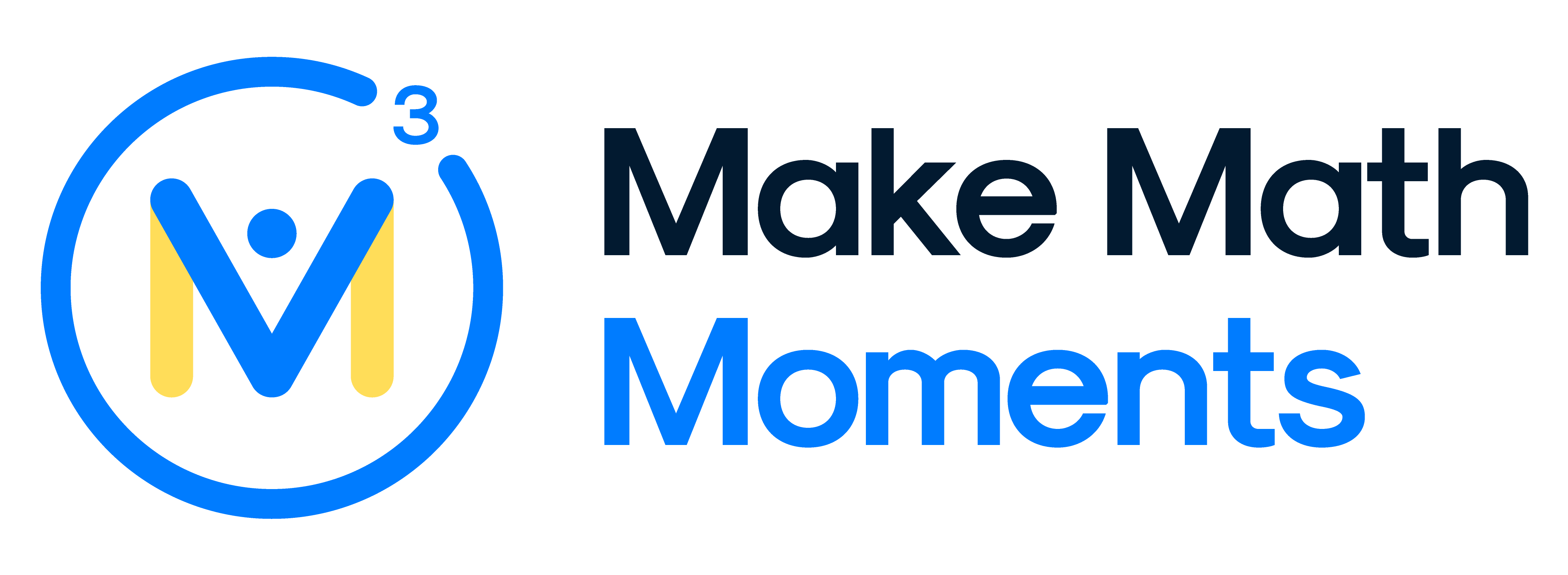



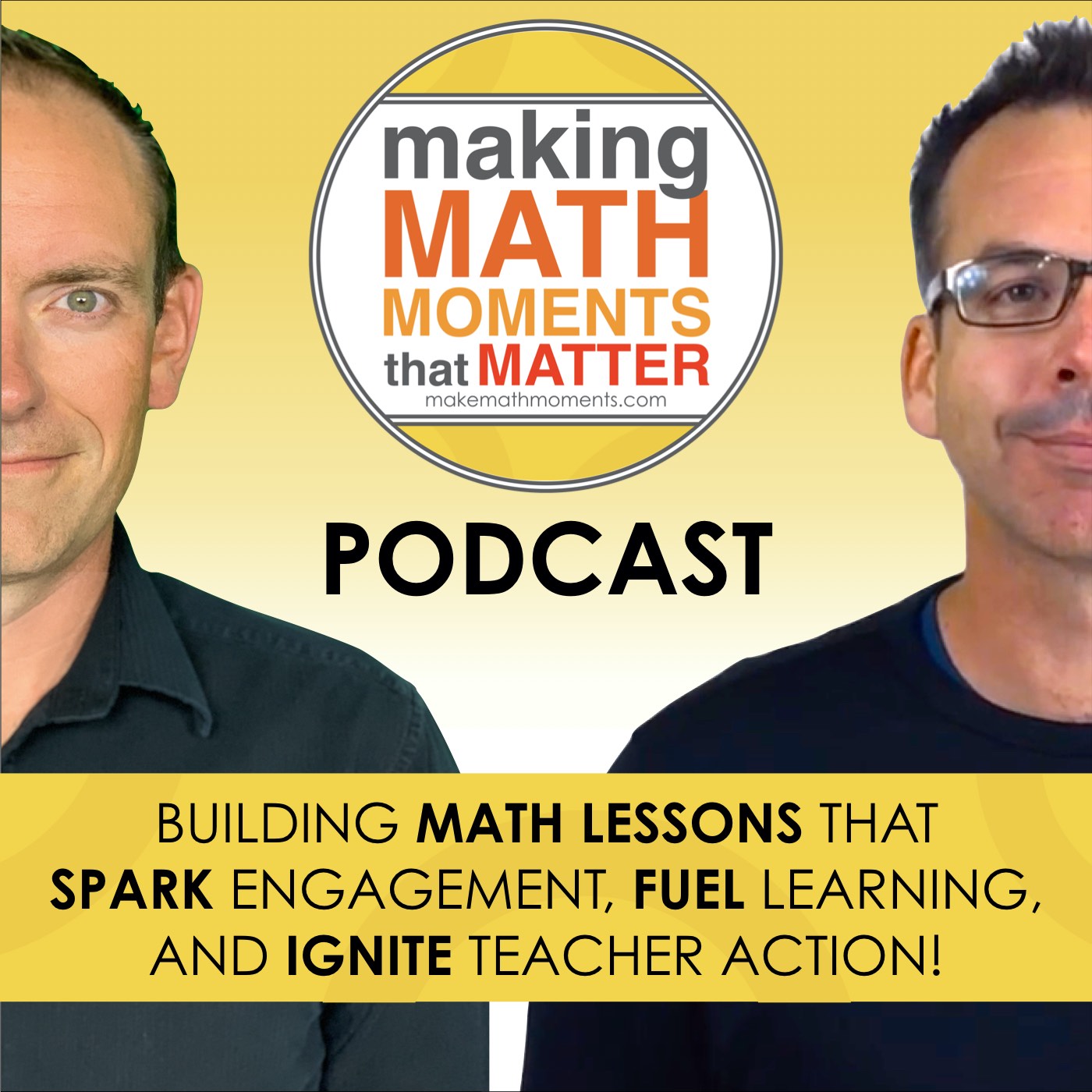
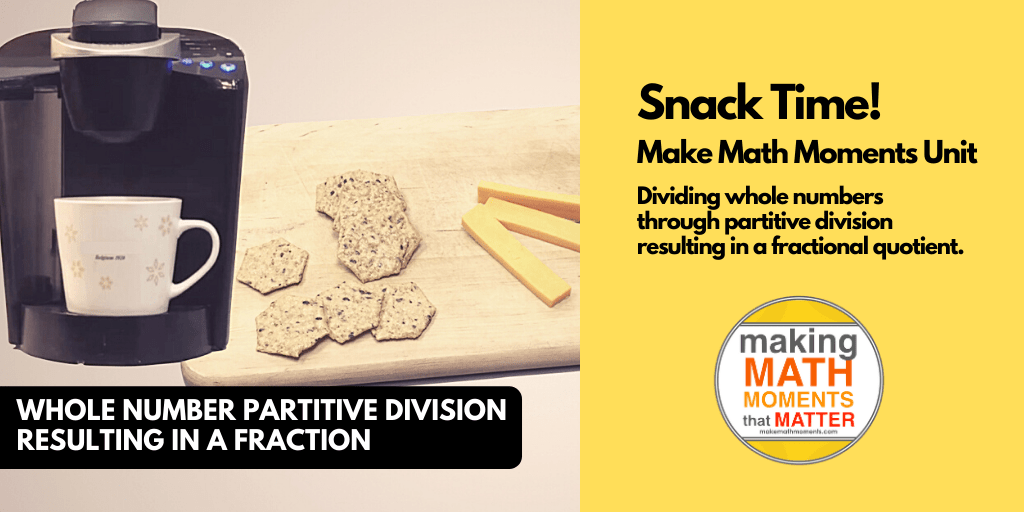
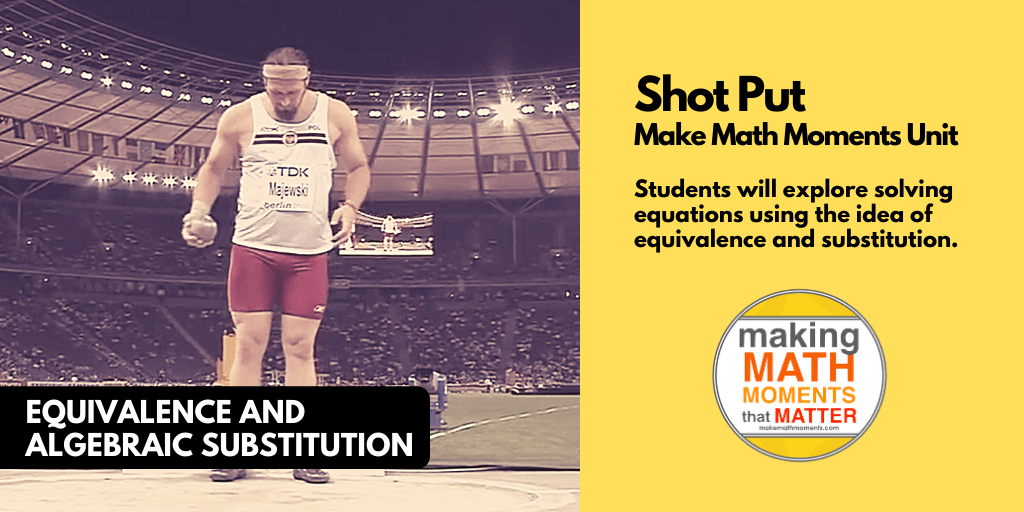
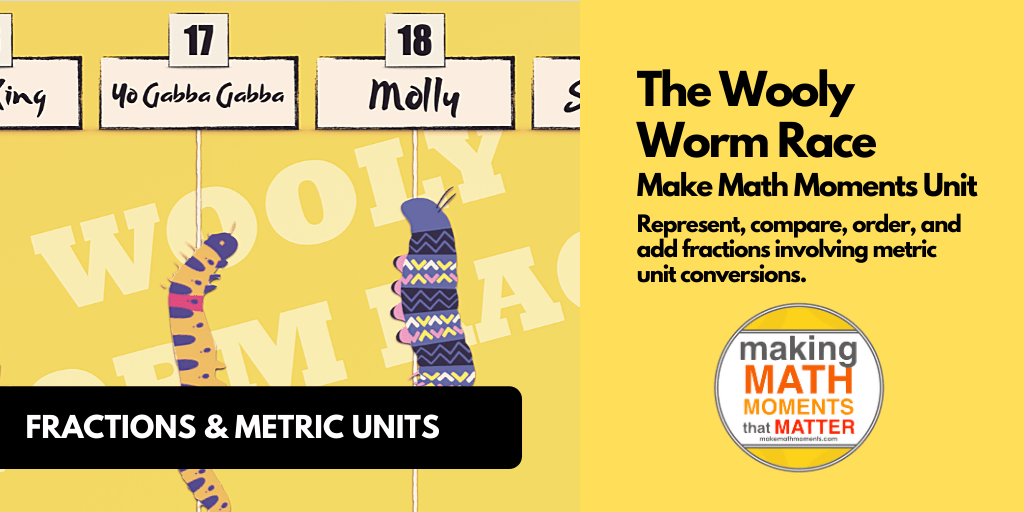
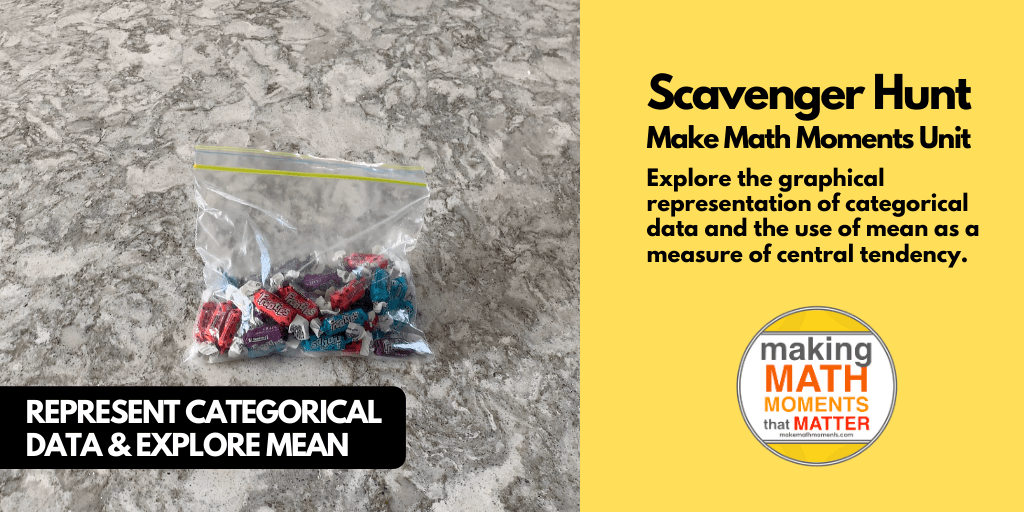
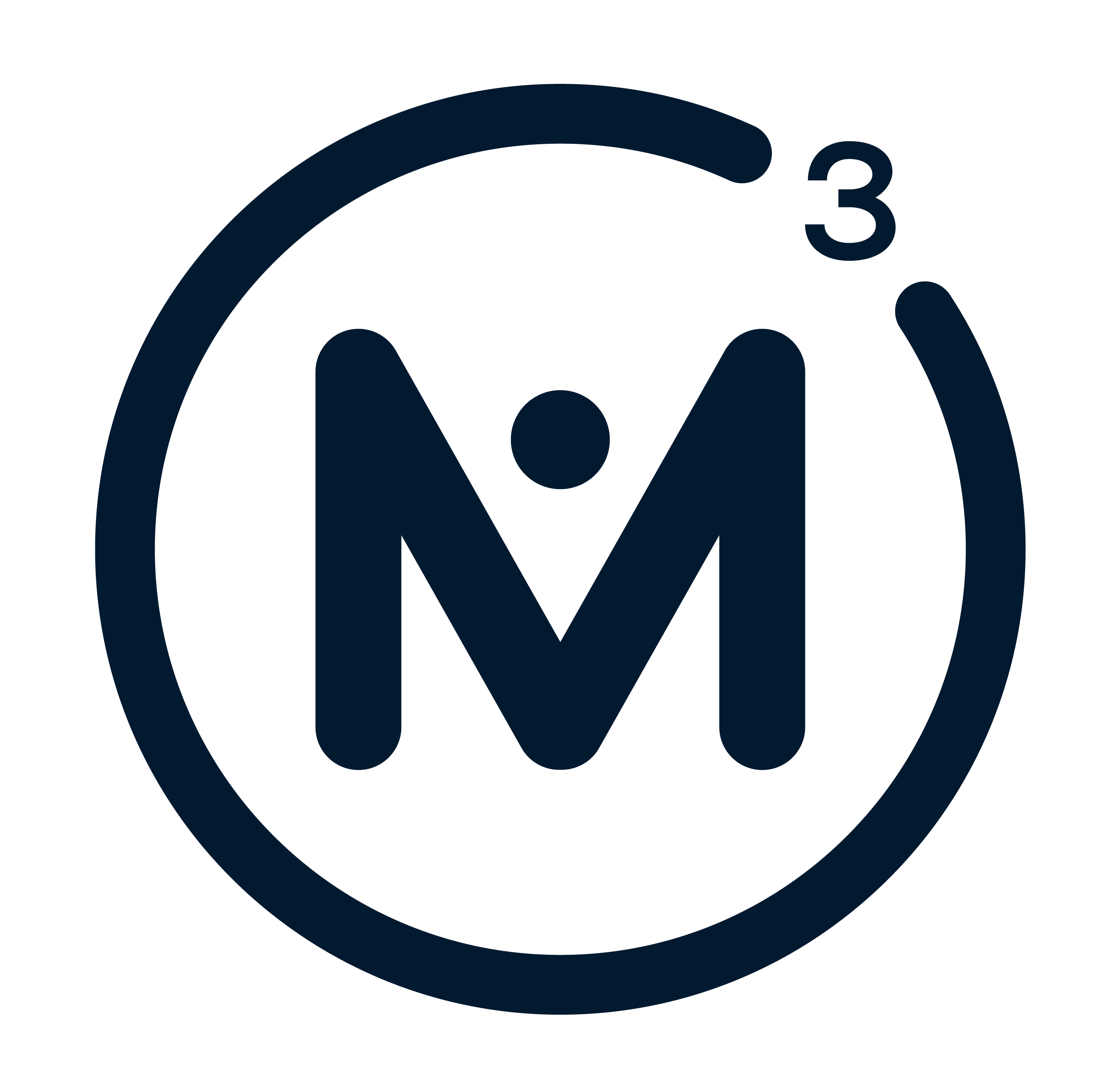
0 Comments